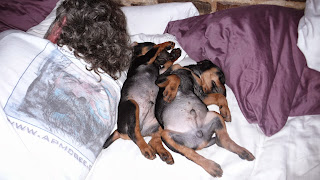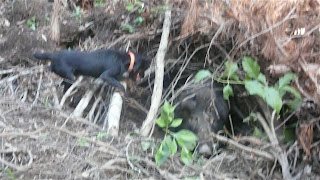mightily to preserving the old type Hunting Airedale from the past. All my Airedales have
a lot Sandhill in their pedigree.
From Henry,
(1) There are three categories of hog dogs. Strike dogs, bay dogs, and
catch dogs. The ideal hog dog will combine the capabilities of all three
types.
(2) The job of the strike dog is to find the hogs. You do not want cold
trailing hounds for that. You don't care where the hogs were two days or
six hours ago. You want to know where they are now. Natural air
scenting dogs like bird dogs and Airedales are the best choice for strike
dogs. To get the most out of them, try to start the hunt from the
downwind edge of the block of ground to be hunted. Work the dogs across
wind, at about 90 degrees to wind direction. If nothing found on the
first crossing, zig zag back across the block in a somewhat more upwind
direction. Keep doing that, each crossing of the block being a little
further upwind. Good air scenting dogs can detect and strike on the
scent of hogs a quarter mile or more away if the wind is favorable.
(3) The job of the bay dog is to threaten the hogs enough to cause them
to go into a mill and to hold them there at bay by threat and maneuver.
You do not want too much aggression in bay dogs. You do not want them to
pitch into the hogs and cause them to break bay. You do not want your
dogs running the hogs deeper into the swamp, across the river, or into
the next county.
(4) There are two types of catch dog. The 100% dedicated catch
specialist like the Pit Bull or Mastiff type and the versatile bay dog
type that has some catch in them and will do that when you get to the bay
and encourage them to catch.
(5) You do not want to turn the dedicated catch dog loose until you are
within 100 or 200 feet of the bay. If he is hunting free he will pitch
into any hogs he finds and cause them to break bay and scatter to the far
winds. Or he will catch and hold far ahead of you. That is a formula
for injury or death of the dog because he can only hold a bad hog for so
long. Then if he has to release or shift his hold he is at that moment
at risk of serious injury from an experienced fighting boar. Ideally you
should be very close and quick to support the dedicated catch dog when he
pulls a hog down. A disadvantage of the dedicated catch dog is that you
have to keep him on lead through briars, down timber, and swamp
conditions until you get to the bay. With some dedicated catch dog
individuals there may also be some risk of them getting excited or
frustrated and catching on a friendly dog or maybe even one of the humans
(I heard of that happening once.)
(6) The versatile bay dog that also has some catch in him is ideal if he
will not try to catch until you get to the bay but then will go in and
catch when encouraged to do so.
(7) Jagdterriers. The full blood Jagdterrier is normally very
aggressive, almost suicidal in his eagerness to fight and catch or kill
his opponent. They will cause hogs to break bay and will run them far
away but are too small to bring a big hog down on their own. You do not
want full blood Jagdterriers in a hog dog pack. Jagdterrier crosses on
the other hand can be highly effective if crossed on dogs that calm them
down and instill some intelligence so they become versatile
baydog/catchdog types that catch only on command.
(8) Bobby Harper, Pembroke, Georgia has hunted hogs for 60 years and is
still actively breeding a line of hog-hunting curs and taking them into
the swamp and catching hogs with them at 77 years of age. His line of
curs is 5/8ths bird dog, 2/8ths hound, and 1/8th Pit Bull. The bird dog
blood provides the air scenting ability to find the hogs, the hound blood
provides voice at the bay, and the Pit Bull blood provides the catch on
command quality needed when Bobby gets to the bay. Bobby has used many
different types of dogs on hogs over his lifetime including farm
shepherds, collie mixes, Labrador Retrievers, Belgian Sheepdogs, and
Airedales. The cur line he has now represents the sum total of his
experience of what works best for him. By the way, he also still keeps
and hunts the full blood Airedale on hogs with good success.
(9) Airedales. The Airedale is a highly intelligent and versatile
general purpose hunting dog. They are natural airborne scenters with a
nose as good as the average bird dog. They will find hogs for you. They
are intelligent enough to learn to use tactics and bay only until you get
to the bay and then will catch on command. The terrier blood in them
provides all the catch needed. You do not need to add any Pit Bull or
Masiff blood to the Airedale.
(10) Airedale crosses can make very good hunting dogs. For hogs, think
about crosses of Airedales to Jagdterriers, Lakeland Terriers, hounds,
bird dogs, Border Collies, Blackmouth Curs, and farm shepherd mixes of
all types. Check the local dog pound or dog rescue every now and then
and I'll bet you can find mixed breed or purebood types that will cross
well with the Airedale to make good hog dogs.
Just my thinking on the subject of hog dogs. Might be right, might be
wrong. You need to think about this and make your own decision about
what works best for you.
hsj, fults cove, Tennessee
257/88
catch dogs. The ideal hog dog will combine the capabilities of all three
types.
(2) The job of the strike dog is to find the hogs. You do not want cold
trailing hounds for that. You don't care where the hogs were two days or
six hours ago. You want to know where they are now. Natural air
scenting dogs like bird dogs and Airedales are the best choice for strike
dogs. To get the most out of them, try to start the hunt from the
downwind edge of the block of ground to be hunted. Work the dogs across
wind, at about 90 degrees to wind direction. If nothing found on the
first crossing, zig zag back across the block in a somewhat more upwind
direction. Keep doing that, each crossing of the block being a little
further upwind. Good air scenting dogs can detect and strike on the
scent of hogs a quarter mile or more away if the wind is favorable.
(3) The job of the bay dog is to threaten the hogs enough to cause them
to go into a mill and to hold them there at bay by threat and maneuver.
You do not want too much aggression in bay dogs. You do not want them to
pitch into the hogs and cause them to break bay. You do not want your
dogs running the hogs deeper into the swamp, across the river, or into
the next county.
(4) There are two types of catch dog. The 100% dedicated catch
specialist like the Pit Bull or Mastiff type and the versatile bay dog
type that has some catch in them and will do that when you get to the bay
and encourage them to catch.
(5) You do not want to turn the dedicated catch dog loose until you are
within 100 or 200 feet of the bay. If he is hunting free he will pitch
into any hogs he finds and cause them to break bay and scatter to the far
winds. Or he will catch and hold far ahead of you. That is a formula
for injury or death of the dog because he can only hold a bad hog for so
long. Then if he has to release or shift his hold he is at that moment
at risk of serious injury from an experienced fighting boar. Ideally you
should be very close and quick to support the dedicated catch dog when he
pulls a hog down. A disadvantage of the dedicated catch dog is that you
have to keep him on lead through briars, down timber, and swamp
conditions until you get to the bay. With some dedicated catch dog
individuals there may also be some risk of them getting excited or
frustrated and catching on a friendly dog or maybe even one of the humans
(I heard of that happening once.)
(6) The versatile bay dog that also has some catch in him is ideal if he
will not try to catch until you get to the bay but then will go in and
catch when encouraged to do so.
(7) Jagdterriers. The full blood Jagdterrier is normally very
aggressive, almost suicidal in his eagerness to fight and catch or kill
his opponent. They will cause hogs to break bay and will run them far
away but are too small to bring a big hog down on their own. You do not
want full blood Jagdterriers in a hog dog pack. Jagdterrier crosses on
the other hand can be highly effective if crossed on dogs that calm them
down and instill some intelligence so they become versatile
baydog/catchdog types that catch only on command.
(8) Bobby Harper, Pembroke, Georgia has hunted hogs for 60 years and is
still actively breeding a line of hog-hunting curs and taking them into
the swamp and catching hogs with them at 77 years of age. His line of
curs is 5/8ths bird dog, 2/8ths hound, and 1/8th Pit Bull. The bird dog
blood provides the air scenting ability to find the hogs, the hound blood
provides voice at the bay, and the Pit Bull blood provides the catch on
command quality needed when Bobby gets to the bay. Bobby has used many
different types of dogs on hogs over his lifetime including farm
shepherds, collie mixes, Labrador Retrievers, Belgian Sheepdogs, and
Airedales. The cur line he has now represents the sum total of his
experience of what works best for him. By the way, he also still keeps
and hunts the full blood Airedale on hogs with good success.
(9) Airedales. The Airedale is a highly intelligent and versatile
general purpose hunting dog. They are natural airborne scenters with a
nose as good as the average bird dog. They will find hogs for you. They
are intelligent enough to learn to use tactics and bay only until you get
to the bay and then will catch on command. The terrier blood in them
provides all the catch needed. You do not need to add any Pit Bull or
Masiff blood to the Airedale.
(10) Airedale crosses can make very good hunting dogs. For hogs, think
about crosses of Airedales to Jagdterriers, Lakeland Terriers, hounds,
bird dogs, Border Collies, Blackmouth Curs, and farm shepherd mixes of
all types. Check the local dog pound or dog rescue every now and then
and I'll bet you can find mixed breed or purebood types that will cross
well with the Airedale to make good hog dogs.
Just my thinking on the subject of hog dogs. Might be right, might be
wrong. You need to think about this and make your own decision about
what works best for you.
hsj, fults cove, Tennessee
257/88










































